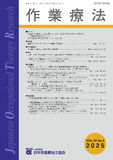Japanese
English
- 販売していません
- Abstract 文献概要
- 1ページ目 Look Inside
- 参考文献 Reference
- サイト内被引用 Cited by
要旨:本報告の目的は,高次脳機能障害者の復職支援において,医療機関所属の作業療法士が両立支援制度を活用する有用性を示すことである.両立支援制度を導入した復職支援7事例を対象に,質的帰納的分類法を用いて分析を行った.分析結果より,復職に際して職場は「職務遂行に必要な基本的能力」「具体的な業務遂行能力」を対象者に求めていた.また作業療法士は他職種とともに「就業上生じる課題と対応方法の提示」「復職可能の判断」「復職フォローアップ体制」を指導した.両立支援制度は,アウトリーチ支援が困難な医療機関所属の作業療法士にとって,就業指導上の要点を明確にし,作業療法士の視点を反映させた指導を行う点で有用である.
This report presents the effectiveness of using the work-treatment balance system by occupational therapists working in medical institutions to support the return-to-work process for people with higher brain dysfunction. We conducted a qualitative content analysis of the actual implementation of the work-treatment balance system, targeting seven cases of return-to-work support that introduced this system. The analysis showed that workplaces required employees to possess “basic skills necessary to perform their job duties” and “specific job performance skills” upon their return. In addition, occupational therapists and other professionals provided guidance on “identifying employment-related problems caused by higher brain dysfunction and addressing them,” “assessing the feasibility of returning to work,” and “establishing a return-to-work follow-up system.” The work-treatment balance system is particularly useful for occupational therapists who face challenges in providing outreach support, as it clarifies critical points of employment guidance and incorporates the occupational therapist's perspective.

Copyright © 2025, Japanese Association of Occupational Therapists. All rights reserved.


